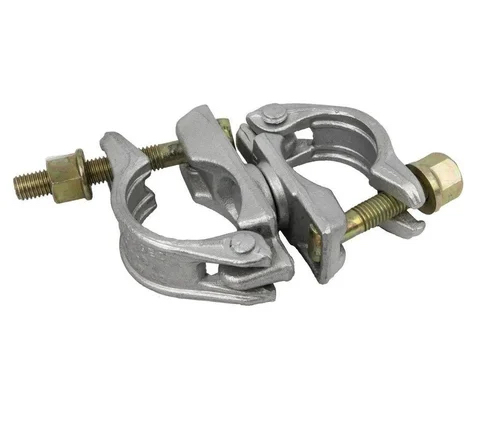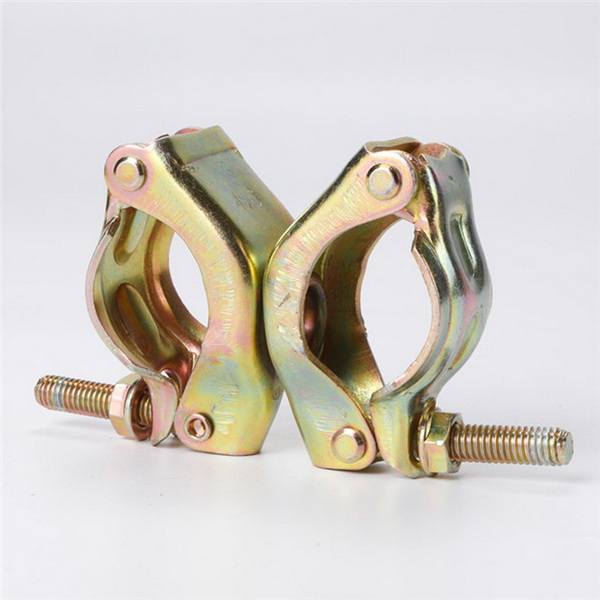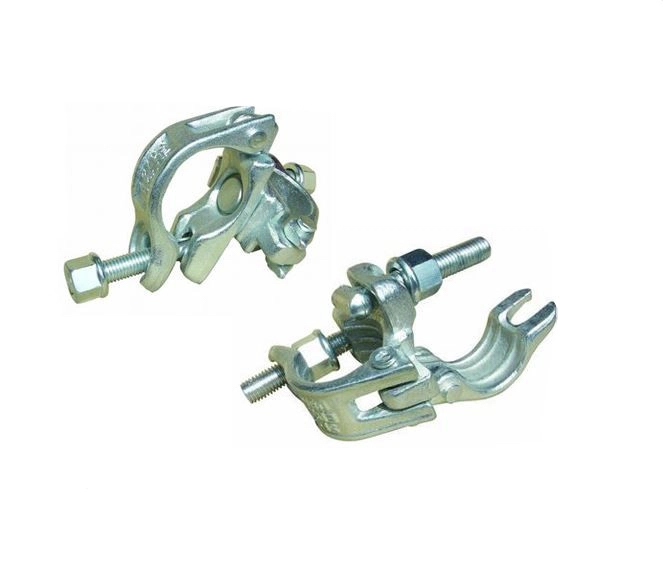Content Menu
● What Are Double Scaffolding Clamps?
● Standard Tube Sizes and Clamp Compatibility
>> Common Scaffold Tube Sizes
>> Clamp Size and Fit
● Material and Manufacturing Standards
>> Materials
>> Standards and Certifications
● Are Double Scaffolding Clamps Universally Compatible?
>> Compatibility Factors
>> When Are Double Scaffolding Clamps NOT Compatible?
● Load Capacity and Safety Considerations
>> Load Ratings
>> Proper Use and Inspection
● Best Practices for Ensuring Compatibility
● Advanced Insights: Factors Affecting Clamp and Tube Compatibility
>> 1. Environmental Conditions
>> 2. Tube Wall Thickness
>> 3. Clamp Design Variations
>> 4. Interchangeability with Other Clamp Types
>> 5. Regional and Project-Specific Requirements
● Troubleshooting Common Compatibility Issues
>> Problem 1: Clamp Won't Tighten Properly
>> Problem 2: Slippage After Assembly
>> Problem 3: Clamp Corrosion or Wear
● Case Study: Double Scaffolding Clamp Selection in Real Projects
>> Scenario: International Construction Site
● Conclusion
● FAQ
>> 1. Are double scaffolding clamps compatible with all tube sizes?
>> 2. Can I use a double scaffolding clamp on aluminum tubes?
>> 3. What happens if I use a clamp on a tube that is too small or too large?
>> 4. Are there double scaffolding clamps for tubes other than 48.3 mm?
>> 5. How do I ensure my clamps and tubes are compatible and safe to use?
Double scaffolding clamps-also known as double couplers or right-angle couplers-are the backbone of tube-and-clamp scaffolding systems. They are essential for securely joining two scaffold tubes at a 90-degree angle, providing the rigidity and strength required for safe and stable scaffold structures. But are these versatile fittings truly compatible with all tubes? This comprehensive guide explores the answer in depth, examining standards, tube sizes, materials, safety considerations, and practical tips for ensuring the right fit and maximum performance.

What Are Double Scaffolding Clamps?
Double scaffolding clamps are mechanical fittings designed to connect two scaffold tubes at a right angle. They are fundamental in constructing the grid-like frameworks that support workers, materials, and equipment on construction sites.
Key Features:
- Joins two tubes at 90 degrees (right angle)
- Available in various materials (forged steel, pressed steel, aluminum)
- Designed for high load-bearing capacity
- Used for both vertical and horizontal connections in scaffolding
Standard Tube Sizes and Clamp Compatibility
Common Scaffold Tube Sizes
The vast majority of double scaffolding clamps are designed for industry-standard tube diameters. The most common sizes are:
| Tube Standard | Outside Diameter (OD) | Common Use Regions |
| BS1139/EN39 | 48.3 mm | UK, Europe, Global |
| JIS/KS | 48.6 mm | Japan, Korea |
| Other Sizes | 42 mm, 60 mm, 76 mm, 89 mm | Specialized Applications |
- 48.3 mm OD: The global standard for most scaffolding systems, especially in Europe, the UK, and many international markets.
- 48.6 mm OD: Common in Japanese and Korean standards.
- Other sizes: Used for specialized or heavy-duty scaffolding, such as industrial or offshore applications.
Clamp Size and Fit
Double scaffolding clamps are manufactured to fit specific tube diameters. The most widely available double couplers are made for 48.3 mm OD tubes, but variants exist for other sizes. Using a clamp on a tube outside its designed range can compromise safety and structural integrity.
“The most used scaffold double coupler is OD48.3mm. Other sizes of OD48.6mm, O42mm, OD60mm, OD76, and OD89mm double couplers are available too. The different sizes of scaffold double couplers are used to connect different diameters of the scaffolding poles (or scaffold pipes).”
Material and Manufacturing Standards
Materials
- Drop-Forged Steel: High strength, excellent durability, and preferred for heavy-duty scaffolding. Often hot-dip galvanized for corrosion resistance.
- Pressed Steel: Lighter and suitable for less demanding applications.
- Aluminum: Used where weight reduction is critical, but with lower load capacity.
Standards and Certifications
- EN74 / BS1139: European and British standards for scaffolding couplers, specifying dimensions, materials, and load capacities.
- OSHA (US): Occupational safety standards for scaffolding components.
Compliance with these standards ensures that double scaffolding clamps are safe, reliable, and compatible with standard tubes.
Are Double Scaffolding Clamps Universally Compatible?
Compatibility Factors
While double scaffolding clamps are designed for versatility, their compatibility is not universal. Key factors include:
- Tube Diameter: Clamps are engineered for specific tube sizes (most commonly 48.3 mm OD). Using them on tubes with different diameters can result in a poor fit, slippage, or structural failure.
- Tube Material and Wall Thickness: Standard clamps are intended for steel or aluminum tubes with industry-standard wall thicknesses (e.g., 3.2 mm or 4.0 mm for BS1139 tubes).
- Clamp Material and Design: Heavier, forged steel clamps offer greater strength and are suitable for heavy-duty applications, while lighter pressed steel or aluminum clamps are for lighter loads.
- Regional Standards: Some regions use slightly different tube sizes (e.g., 48.6 mm in Japan/Korea). Manufacturers often produce clamps for these specific markets.
When Are Double Scaffolding Clamps NOT Compatible?
- Non-standard Tube Sizes: Using a 48.3 mm clamp on a 42 mm or 60 mm tube will not provide a secure connection.
- Non-circular Tubes: Clamps are designed for round tubes; they will not fit square or rectangular profiles.
- Damaged or Deformed Tubes: Bent, dented, or corroded tubes may not seat properly in the clamp, compromising safety.

Load Capacity and Safety Considerations
Load Ratings
- Forged Steel Double Couplers: Typically rated for loads exceeding 30 kN (EN74 Class B standard).
- Pressed Steel Couplers: Slightly lower load capacity, but still meet safety standards.
- Aluminum Couplers: Lower load capacity, suitable for lighter applications.
“The double coupler can hold weights more than 30 KN (meet up EN74 Class B standard).”
Proper Use and Inspection
- Always use clamps and tubes that are certified and designed to work together.
- Tighten clamps to the manufacturer's recommended torque (typically 54 Nm).
- Regularly inspect clamps for wear, corrosion, or damage; replace as needed.
Best Practices for Ensuring Compatibility
- Check Tube Diameter: Always verify the outside diameter of your scaffold tubes and match them to the clamp's specification.
- Use Certified Components: Only use clamps and tubes that meet recognized standards (EN74, BS1139, OSHA).
- Inspect Before Use: Check for damage, corrosion, or deformation in both clamps and tubes.
- Follow Manufacturer Instructions: Adhere to recommended tightening torque and assembly procedures.
- Mixing Clamps and Tubes: If using tubes of different standards (e.g., 48.3 mm and 48.6 mm), ensure the clamps are rated for both sizes or use dedicated clamps for each.
Advanced Insights: Factors Affecting Clamp and Tube Compatibility
1. Environmental Conditions
Corrosive environments, such as coastal or industrial sites, can affect both tubes and double scaffolding clamps. Galvanized or stainless steel clamps are recommended for such settings. Corrosion can reduce the effective diameter of tubes, making clamps less secure over time.
2. Tube Wall Thickness
While the outside diameter is the primary compatibility factor, wall thickness affects the tube's strength and how much load the clamp can safely transfer. Thinner-walled tubes may deform under clamp pressure, so always use tubes with wall thicknesses recommended by standards (typically 3.2–4.0 mm for steel tubes).
3. Clamp Design Variations
Some double scaffolding clamps feature enhanced grip surfaces or integrated anti-slip mechanisms. These may offer improved performance on tubes with surface coatings or in high-vibration environments.
4. Interchangeability with Other Clamp Types
Double scaffolding clamps are often used in conjunction with other fittings, such as swivel couplers (for angled connections) and sleeve couplers (for end-to-end joining). While these clamps may look similar, they are not always interchangeable-each is designed for specific structural roles.
5. Regional and Project-Specific Requirements
Certain countries or projects may require specific certifications or testing for all scaffolding components, including double scaffolding clamps. Always check local regulations and project specifications before selecting clamps and tubes.
Troubleshooting Common Compatibility Issues
Problem 1: Clamp Won't Tighten Properly
Possible Causes:
- Tube diameter is too small or too large for the clamp
- Tube is deformed, dented, or corroded
- Clamp is worn or damaged
Solution:
- Verify tube diameter, inspect both tube and clamp for damage, and replace any non-compliant parts.
Problem 2: Slippage After Assembly
Possible Causes:
- Incorrect clamp size for tube
- Insufficient tightening torque
- Contaminants (oil, paint, rust) on tube surface
Solution:
- Clean tube, ensure correct clamp size, and tighten to recommended torque.
Problem 3: Clamp Corrosion or Wear
Possible Causes:
- Prolonged exposure to moisture or chemicals
- Use of non-galvanized clamps in harsh environments
Solution:
- Use galvanized or stainless steel clamps, and regularly inspect and replace as needed.
Case Study: Double Scaffolding Clamp Selection in Real Projects
Scenario: International Construction Site
A multinational construction company is assembling scaffolding for a high-rise project in a coastal city. The site uses both European-standard 48.3 mm OD tubes and some locally sourced 48.6 mm OD tubes.
Challenges:
- Ensuring all double scaffolding clamps fit both tube sizes securely
- Preventing corrosion from salty air
- Meeting both local and international safety standards
Solutions:
- Sourcing double scaffolding clamps rated for both 48.3 mm and 48.6 mm OD
- Using hot-dip galvanized clamps for corrosion resistance
- Conducting regular inspections and torque checks
Outcome:
- The project maintained high safety standards, avoided compatibility issues, and minimized downtime due to clamp or tube failures.
Conclusion
Double scaffolding clamps are not universally compatible with all tubes-they are specifically engineered for certain tube diameters, most commonly 48.3 mm OD, as defined by international standards like BS1139 and EN39. While manufacturers offer clamps for other tube sizes (such as 48.6 mm, 42 mm, or 60 mm), using the wrong size clamp for a given tube can compromise the safety and stability of the scaffold structure.
To ensure safe and effective scaffolding:
- Always match clamp size to tube diameter.
- Use certified, standard-compliant components.
- Regularly inspect and maintain all fittings.
- Follow manufacturer guidelines and local safety regulations.
By following these best practices, you can maximize the safety, reliability, and versatility of your tube-and-clamp scaffolding system.

FAQ
1. Are double scaffolding clamps compatible with all tube sizes?
No, double scaffolding clamps are designed for specific tube diameters, most commonly 48.3 mm OD. Using them on non-standard tube sizes can result in an insecure fit and potential safety hazards.
2. Can I use a double scaffolding clamp on aluminum tubes?
Yes, as long as the tube's outside diameter matches the clamp's specification (e.g., 48.3 mm), double scaffolding clamps can be used on both steel and aluminum tubes.
3. What happens if I use a clamp on a tube that is too small or too large?
Using a clamp on a tube that does not match its designed diameter can lead to slippage, inadequate load-bearing, and increased risk of structural failure. Always use the correct size clamp for your tubes.
4. Are there double scaffolding clamps for tubes other than 48.3 mm?
Yes, manufacturers produce double scaffolding clamps for other tube sizes such as 48.6 mm, 42 mm, 60 mm, and larger, to suit regional standards and specialized applications.
5. How do I ensure my clamps and tubes are compatible and safe to use?
- Verify the tube diameter and clamp specification.
- Use only certified, standard-compliant components.
- Inspect all parts for damage or wear before use.
- Follow manufacturer instructions for assembly and tightening.






















